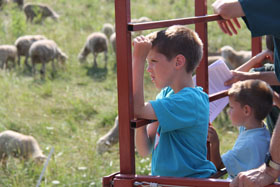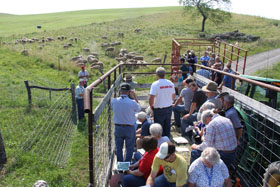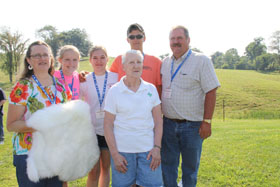
- August 2014
- President’s Notes
- Market Report
- Letters to Vilsack Express Industry Concern Over Grazing Allotments
- Sheep Experiment Station Granted New Life
- News Briefs
- Amidst Drought and Predators, Some Texas Wool-Sheep Producers Vow to Stick it Out
- Ohio Sheep Day: Annual Event’s Goal is to Keep Sheep State’s Infrastructure Shipshape
- Let’s Grow: New Mexico Hoping Taylor Ranch Flock Can Help Turn Back the Sheep Clock
- Researcher With Interest in Feed Value of Woody Plants is ASI Scholarship Winner
- Moving Forward in Montana
- Lamb Board’s Direct Marketing Study Aimed at Helping Industry Understand Growing Sector
Ohio Sheep Day: Annual Event’s Goal is to Keep Sheep State’s Infrastructure Shipshape
 Daryl Clark opened the 2014 Ohio Sheep Day by making a not-uncommon request in the sheep industry.
Daryl Clark opened the 2014 Ohio Sheep Day by making a not-uncommon request in the sheep industry.
“We need more sheep in Ohio,” said Clark, president of the Ohio Sheep Improvement Association. Clark’s call for growth isn’t an empty one. As he points out, “Ohio has great infrastructure for sheep and growth, but that infrastructure won’t be around forever, especially if we don’t use it.”
And so a day of sheep education and sharing of information began.
The day-long program was held at the Shawn Ray family farm, located just outside of Cumblerland in the southeast corner of the state. Ray and his family raise sheep, goats and cattle.
“But out main enterprise is sheep,” Ray, who runs about 150 ewes, said. Ray provided a wagon tour of his family’s hilly pasturelands, while Ohio State University Extension Educator Clif Little and Bob Hendershot of Green Pasture Services offered producers advice on pasture management.
 Back at the Ray home, the ASI Eastern Region Predator Control Workshop was held in two separate sessions.
Back at the Ray home, the ASI Eastern Region Predator Control Workshop was held in two separate sessions.The predator workshop was designed to provide farmers and producers with effective use of guard animals, nonlethal control methods, and the utilization of trapping, snaring and protection collars, Roger High, state sheep extension associate and executive director of OSIA, said. High noted that Ohio sheep’s biggest predator threats are coyotes and black vultures. APHIS staff joined biologists from the Ohio Division of Wildlife in presenting on state predator programs and philosophies.
The Ohio Department of Agriculture provided a seminar on basic sheep management and set-up of lambing barn operations.
Sheep experts and speakers also provided information about EQIP (Environmental Quality Incentives Program) practices, agricultural lime application and pasture renewal, and the latest sheep equipment, High said, adding, “A large benefit of attending Ohio Sheep Day is not only the information gained from the speakers, but the invaluable experience of speaking and sharing ideas with other sheep producers and farmers.”
On the day before the July 12 event, a number of producers participated in a Sheep Grazing and Forage  Management Tour, sponsored by OSIA, OSU Extension and the Ohio Forage and Grassland Council. The tour included stops on property owned by Bob Ball, Dick and Kaye Clay and Rick Moore.Producers learned about the region’s forage and also about the effects of the expanding gas industry in Ohio. Participants were guided to live gas wells and provided first-hand experiences on having gas pipelines constructed on pasturelands and farm properties.
Management Tour, sponsored by OSIA, OSU Extension and the Ohio Forage and Grassland Council. The tour included stops on property owned by Bob Ball, Dick and Kaye Clay and Rick Moore.Producers learned about the region’s forage and also about the effects of the expanding gas industry in Ohio. Participants were guided to live gas wells and provided first-hand experiences on having gas pipelines constructed on pasturelands and farm properties.
 Management Tour, sponsored by OSIA, OSU Extension and the Ohio Forage and Grassland Council. The tour included stops on property owned by Bob Ball, Dick and Kaye Clay and Rick Moore.Producers learned about the region’s forage and also about the effects of the expanding gas industry in Ohio. Participants were guided to live gas wells and provided first-hand experiences on having gas pipelines constructed on pasturelands and farm properties.
Management Tour, sponsored by OSIA, OSU Extension and the Ohio Forage and Grassland Council. The tour included stops on property owned by Bob Ball, Dick and Kaye Clay and Rick Moore.Producers learned about the region’s forage and also about the effects of the expanding gas industry in Ohio. Participants were guided to live gas wells and provided first-hand experiences on having gas pipelines constructed on pasturelands and farm properties.
Clark, who raises sheep in Zanesville, said the southeast part of Ohio is ideal for raising sheep – plenty of land that can be managed for foraging. A former Extension educator, he has been working with Amish farmers who have become involved in producing sheep in recent years. Clark’s intent is simple: put more sheep on the ground in his home state.
“Ohio has the most sheep east of the Mississippi River, and we also have a good number of people like Roger High who are able to educate others about sheep, but when people like Roger are gone, that infrastructure I talk about will begin to erode,” said Clark.

